EXCEPTS FROM CHINESE DANCE
by Sun Jingchen, Luo Xiongyan, Zi Huayun
Harmony and Serenity
Rhythm of Farming
Farming relies on land, sufficient water and sunlight. After a period of time, people see their harvest. Because of the peasants' love for land and expectation for harvest, they learned how to live in harmony with nature. As a result, the folk dances about the farming culture have a harmonious, serene, steady and slow rhythm. The dancing team changes but always with balance. The song, dance and skill integrate perfectly. Stage props are put into a full use. Drums are used as an accompaniment. Performance is made in accordance with agricultural seasons, usually on the "Spring Festival" or the "Lantern Festival". The "drum dance" pioneered the farming dances, and "yangge" (a rural folk dance) and "Gaoqiao yangge" (walking and dancing on stilts) became the most popular.
The drum sound was associated with thunder, meaning it could bring rain and be beneficial to farms and plant Cultivation. The combination of drum and dance lasted a long time. From the sentence "Beat drums and dance to one's heart content", the combination of drum and dance not only produces various forms, but also encourages people to unite and struggle forward. The dance accompanied by drum is used in making sacrifices to ancestors, praying for rain, dispersing evils, encouraging people and celebrating harvests. Therefore, many kinds of drums are made and dance forms are diversified. For instance, Va and Miao ethnic groups use simple wooden drums (cut out of a section of logl. Zhuang and Yao nationafities use pottery drums during their dances. The drum cavity is made of pottery clay, inherited from the earth drum. The Miao, Yao and Bouyei nationalities use bronze drums, the relics from the Bronze Age. 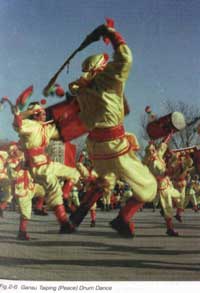 All these drums remain from the primitive period. The Korean "Zhang (stick) Drum Dance", also called "Long-Drum Dance", is left and extended from the "LiangZhang (two-stick) Drum Dance" of the Tang Dynasty (see Annals of Chinese Ethnic Groups' Musical instruments), which can be identified by its drum shape and the way it is beaten. The Korean minority developed it into a beautiful dance form with a strong local flavor, which spread widely among themselves. The drum dances of the Han nationality are diversified; they depict team spirit, individual techniques, or something else. Now all the dances have taken on new appearances. In the Taiping (Peace) Drum Dance found in Lanzhou, Gansu Province, performers are usually men. They carry a barrel-shaped drum, which is one meter long and 0.5 meter in diameter, with an imposing manner The thundering sound can be heard half or one kilometer away Performers dance freely with such a huge drum. Also, they must perform difficult programs Such as "sparrow hawk turning upside down" and "whipping one's horse on", Especially in the program of "bending the bow and shooting goose", performers have to jump up to the sky, with one hand carrying the drum and the other hand beating, which inspires and encourages people. (Fig. 2-6)
All these drums remain from the primitive period. The Korean "Zhang (stick) Drum Dance", also called "Long-Drum Dance", is left and extended from the "LiangZhang (two-stick) Drum Dance" of the Tang Dynasty (see Annals of Chinese Ethnic Groups' Musical instruments), which can be identified by its drum shape and the way it is beaten. The Korean minority developed it into a beautiful dance form with a strong local flavor, which spread widely among themselves. The drum dances of the Han nationality are diversified; they depict team spirit, individual techniques, or something else. Now all the dances have taken on new appearances. In the Taiping (Peace) Drum Dance found in Lanzhou, Gansu Province, performers are usually men. They carry a barrel-shaped drum, which is one meter long and 0.5 meter in diameter, with an imposing manner The thundering sound can be heard half or one kilometer away Performers dance freely with such a huge drum. Also, they must perform difficult programs Such as "sparrow hawk turning upside down" and "whipping one's horse on", Especially in the program of "bending the bow and shooting goose", performers have to jump up to the sky, with one hand carrying the drum and the other hand beating, which inspires and encourages people. (Fig. 2-6)
The "Weifeng Drum Dance" in Lin fen Prefecture, Shanxi Province, has an imposing manner and militant bearing. The dancers express the lofty sentiments and aspirations of the Chinese people, and the drum sound shakes the earth. The performance by a 410-member peasant team at the opening ceremony of the Eighth Asian Games held in Beijing in September 1990 displayed their skill to the fullest.
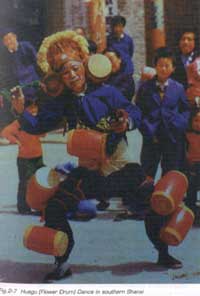 The "Huagu (Flower Drum) Dance" in southern Shanxi Province has different features. Each dancer is highly skillful, with seven small drums tied on him. They dance while beating the drums. The dance is light and the drums sound clear, always attracting a lot of attention. (Fig.2-7)
The "Huagu (Flower Drum) Dance" in southern Shanxi Province has different features. Each dancer is highly skillful, with seven small drums tied on him. They dance while beating the drums. The dance is light and the drums sound clear, always attracting a lot of attention. (Fig.2-7)
"Yaogu" (Waist Drum), especially the "Ansai Yaogu" in northern Shaanxi Province, is famous around the world. Scores of young men play the dance in a group. They combine themselves with the drum into one. Their free and bustling activities display fully the self-confidence and pride of a new generation of Chinese peasants.
Since peasants use various tools and utensils during labor, they use them as stage props in performances. This is another feature of the farming dances. By using common tools, the performers enhance their arms' function, strengthen the expression of human bodies, expand the sphere of art and make their skills more exquisite.
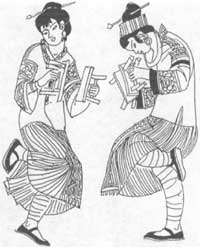 People place their hope for a happy life in different things. For instance, the "Dragon Dance" symbolizes favorable weather; the "Lion Dance" stands for auspiciousness; the "Crane Dance" for a long life and the "Peacock Dance" for happiness and beauty. Some stage props come from laboring tools, which can be seen in Han's "Little Cart Dance", "Land Boat Dance", "Riding a Donkey", "Umbrella Dance" and "Fan Dance". The Yi ethnic group uses a bamboo cigarette box to play out beautiful music and dances under its accompaniment; while the Miao people use a wooden bench during their dances. (Fig.2-8)
People place their hope for a happy life in different things. For instance, the "Dragon Dance" symbolizes favorable weather; the "Lion Dance" stands for auspiciousness; the "Crane Dance" for a long life and the "Peacock Dance" for happiness and beauty. Some stage props come from laboring tools, which can be seen in Han's "Little Cart Dance", "Land Boat Dance", "Riding a Donkey", "Umbrella Dance" and "Fan Dance". The Yi ethnic group uses a bamboo cigarette box to play out beautiful music and dances under its accompaniment; while the Miao people use a wooden bench during their dances. (Fig.2-8)
The dances of minority nationalities using weapons as stage props always appear brave and heroic. In some nationalities that believe in Buddhism or Taoism, one finds "Cymbals Dance", "Lantern Dance" and "Wax Dance". The "Lantern Dance" refers to those performed during the "Lantern Festival".
The peacock is a precious bird in the Sub-tropical zone. It is beautiful and tame. In the mind of the Dai ethnic group, it stands for auspiciousness and beauty. The excellent "Peacock Dance" reflects their respect for peace, honesty, water and beauty. The Dai people believe in Hinayana. In the scripture, the Peacock Rajas (Bright King) is a Bodhisattva flying on a peacock, with lotus and peacock tail in hand. Therefore, the Dai people love peacocks, tame peacocks and dance the "Peacock Dance".
The Zhuang, Bouyei and Dai ethnic groups are all descendants of Baiyue (ancient name of the areas of what are Zhejiang, Fujian and Guangdong today) people good at planting rice. They inherit from their ancestors the "Bronze Dance". Also, they have new dances, including the "Moguai (Frog) Dance" of the Zhuang nationality and the "FangZhi (Weavingl Dance" of the Bouyei nationality.
Ancestors of the Zhuang ethnic group had a frog as a totem. They had a "Frog Festival" and big sacrifices for frogs. In legend, the frog is the son of the God of Thunder, who can give clouds and rain. People, therefore, offer sacrifices to them to pray for a favorable weather images of frogs are found in the unearthed bronze drum today The "Frog festival" is still celebrated in rural areas of Tian'e and Nandan counties of the GuangXi Zhuang Autonomous Region. At that time, a grand ceremony will be held according to traditional Customs. The programs include "The Frog Is Born", "Sacrificing for the Frog" and "Worshipping the Frog". The one performing a frog must have himself painted or wear specially made frog clothes. Other roles, whether male or female, wear a mask and are all played by men.
The "Biandan (Shoulder Pole) Dance" of the Zhuang people comes from their daily work of "rice husking". Performers beat their wooden stools with shoulder poles. During the rhythmic beating, they perform rice planting, harvesting, threshing and husking.
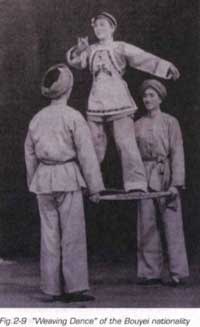 The Bouyei ethnic group in Qiannan Prefecture of Guizhou, who were referred to as "Zhongiia" in ancient time, is famous for the "Zhongiia cloth" and "wax printing". Their "Fangzhi (Weaving) Dance" is performed by three persons. Two men stand facing each other, holding two wooden sticks in their hands; a woman stands on the two sticks and is raised by the men. She acts like a weaver in the air, showing Bouyei women's diligence in farming and weaving. (Fig.2-9)
The Bouyei ethnic group in Qiannan Prefecture of Guizhou, who were referred to as "Zhongiia" in ancient time, is famous for the "Zhongiia cloth" and "wax printing". Their "Fangzhi (Weaving) Dance" is performed by three persons. Two men stand facing each other, holding two wooden sticks in their hands; a woman stands on the two sticks and is raised by the men. She acts like a weaver in the air, showing Bouyei women's diligence in farming and weaving. (Fig.2-9)
Among dances using stage props, the "Dragon Dance" and" Lion Dance" have the longest history and have been spread most widely, which can be found in ancient documents.
In the "Lion Dance", two people act as a lion; one waving the lion head and the other waving the lion body and tail; or one performer acts as a cub. Another person is needed to hold a silk ball to play with the lion. The performance is divided into "Wenshi" (civil) and "Wushi" (martial) types. " Wenshi" depicts the images of a lion, which is docile and funny. It scratches, licks or dozes off. In some areas, the lion player wears a mask. For instance, there are the "Luohan (Arhat) Playing with Lion" in Sichuan and Hunan provinces and the "Laughing Monk Playing with Lion" in Shaanxi Province.
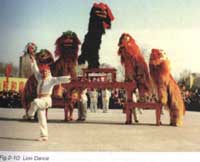 "Wushi" portrays the power of the lion. Besides the usual jumping, falling and tumbling, performers will also show their excellent techniques by climbing upon a high table or by stepping on five wooden stakes. For instance, the "Gaotai (High Stage) Lion Dance" of Sichuan Province has to be performed on seven high tables, which makes the performance highly difficult. In recent years, the "Lion Dance" in Beiing combines the advantages of others to become a new style. (Fig.2-10)
"Wushi" portrays the power of the lion. Besides the usual jumping, falling and tumbling, performers will also show their excellent techniques by climbing upon a high table or by stepping on five wooden stakes. For instance, the "Gaotai (High Stage) Lion Dance" of Sichuan Province has to be performed on seven high tables, which makes the performance highly difficult. In recent years, the "Lion Dance" in Beiing combines the advantages of others to become a new style. (Fig.2-10)
The "Dragon Dance" has diversified models and forms. The dragon is a totem of the Chinese nation. The farming tribes worship it very much. People think dragons can make clouds and bring them rain. Playing dragon dances in the spring will hopefully bring people favorable weather; playing in dry seasons will bring them rain; playing to different families will drive ghosts out. Therefore, the Custom goes on. The dragons are made into different forms, such as the cloth dragon, the grass dragon, the fire dragon and the segment dragon. The play is accordingly different. The cloth dragon has a separate dragon head and body, which is connected with cloth. The longer the dragon is, the more performers there are. One person uses a pearl-like thing to lead the dragon. The dragon will rise or fall, slowly or rapidly. Sometimes, it flies up to the sky, and sometimes it is like hiding under the ocean and breaking waves. The fire dragon is made with candles put into each section of the dragon body. When performed at night, firecrackers are set off. We see an extremely excellent scene of the fire dragon shuttling back and forth among fireworks. The grass dragon, also called "burning incense dragon", is made from rice straw and green vines, with burning incenses inserted into it. Played during summer nights, the dragon is like a meteor attracting a lot of insects. When the play is over, the dragon is put into a pool to drown the insects. Therefore, playing with the grass dragon helps get rid of insects.
 The "Baiye Dragon Dance", popular in Zhejiang Province, is performed by 17 people with specially made stage props in their hands. At first, they sing and dance, like butterflies among flowers. Then, they turn the stage props to form the head and tail of a dragon with some pieces of the lotus-like tools entering the dragon's body When the dragon shoots into the sky, the audience feels the elegance and uniqueness of the dance. (Fig.2-11 )
The "Baiye Dragon Dance", popular in Zhejiang Province, is performed by 17 people with specially made stage props in their hands. At first, they sing and dance, like butterflies among flowers. Then, they turn the stage props to form the head and tail of a dragon with some pieces of the lotus-like tools entering the dragon's body When the dragon shoots into the sky, the audience feels the elegance and uniqueness of the dance. (Fig.2-11 )
For over 2,000 years, the dragon has turned from a symbol of deity, emperor and imperial power into a symbol of the rising Chinese nation. The dragon dance, accordingly, has been elevated from asking for God and rain to expressing people's courage, pride and wisdom.
As mentioned before, the "Yue" in ancient China combined music and dance. Songs and dances are played at the same time, alternately or one accompanying the other.
Many dancers hold a kind of musical instrument. Besides the "Lusheng Dance" of the Miao and Lahu nationalities and "Zhanggu Dance" of the Korean ethnic group, the "Little Sanxian (a three-stringed plucked instrument) Dance" and the "Pip3 (a plucked string instrument with a fretted fingerboard) Dance" of the Lisu ethnic group, the "Sanxian Dance" of the Hani ethnic group and the "Long-Drum Dance" of the Yao ethnic group are all of this kind. The "Two-Person Long-Drum Dance" requires high skill. Performers leap high at one jump, beating the drum in the air; or they dance on a square table.
"yangge" (a popular rural folk dance) and "Gaoqiao" (walking on stilts) are representative dances that combine music, dance and skill. Both of them have a long history and diversified forms.
The "yangge" originates from rice planting and farming. Also, it has some connection with ancient eulogizing songs in sacrifices to the God of Farm. During its development, it incorporated much from the farming songs, "Lingge" (a kind of folk song), folk wushu (a form of physical culture), acrobatics and traditional operas. At last, it became a kind of folk dance. By the Qing Dynasty, the "yangge" had spread widely across the country. People divide it according to areas or its form, for example, the "Drum yangge" in Shandong, the "yangge in northern Shaanxi", the "local yangge" in Hebei, Beijing and Liaoning, the "Manchurian yangge" and the "stilts yangko". Other forms Such as the "Huagu (Flower Drum)", "Huadeng (Festive Lantern)", "Caicha (Tea-Leaf Picking)" and "Yingge" are popular in Guangdong and Hong Kong Special Administrative Region.
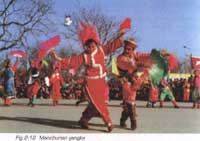 Roles in the "local yangko in eastern Hebei" include niu (girls), chou (clown), gongzi (young men) and laokuai (shrewish old women). Except for laokuai, who hold a wooden club, all others dance with a folding fan in their hands. The performance covers a wide range, and the characters are unique. The most striking performance is made by chou, who is charmingly naive, kind, humorous and optimistic. Closely accompanied by the suona (a kind of horn), which can imitate the sound of people, the chou makes people laugh.
Roles in the "local yangko in eastern Hebei" include niu (girls), chou (clown), gongzi (young men) and laokuai (shrewish old women). Except for laokuai, who hold a wooden club, all others dance with a folding fan in their hands. The performance covers a wide range, and the characters are unique. The most striking performance is made by chou, who is charmingly naive, kind, humorous and optimistic. Closely accompanied by the suona (a kind of horn), which can imitate the sound of people, the chou makes people laugh.
The "Manchurian yangge" is similar to the "local yangge" of Hebei in form, but performers usually wear Manchurian clothes. The dance is free and brisk, imitating the valor of a tribe excelling in horsemanship and marksmanship. (Fig.2-12)
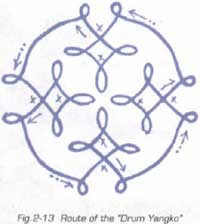 The "Drum Dance", also called "Playing with shougu (a small drum similar to the tambourine)", is popular in rural areas of Shanghe and Huimin, Shandong Province. It is a large-scale dance played during the Spring Festival or other festivals or holidays. The performers have good organization and careful division. When the Spring Festival is coming, each village organizes the youth to learn and rehearse, guided by prestigious artists. The per forming team is usually composed of over 40 performers, who are divided into four kinds of roles: "san", "gu", "bang" and "hua". "Hua" is now per formed by women (in the past, it sometimes was performed by men). The "hua" would hold a folding fan and a handkerchief, while the other three roles hold another kind of stage prop. In the performance, the "san" (umbrella) players are in the front. The dance is led by experienced performers. The well-trained dancers transform their forrnation regularly Their actions are standard and the manner is imposing. A strong local flavor is felt. About 70 kinds of formations and team patterns are preserved, and 20 are in common use. Of all the "yangges" in China, the "Drum yangge" has the most diversified formation and team patterns. (Fig.2-13)
The "Drum Dance", also called "Playing with shougu (a small drum similar to the tambourine)", is popular in rural areas of Shanghe and Huimin, Shandong Province. It is a large-scale dance played during the Spring Festival or other festivals or holidays. The performers have good organization and careful division. When the Spring Festival is coming, each village organizes the youth to learn and rehearse, guided by prestigious artists. The per forming team is usually composed of over 40 performers, who are divided into four kinds of roles: "san", "gu", "bang" and "hua". "Hua" is now per formed by women (in the past, it sometimes was performed by men). The "hua" would hold a folding fan and a handkerchief, while the other three roles hold another kind of stage prop. In the performance, the "san" (umbrella) players are in the front. The dance is led by experienced performers. The well-trained dancers transform their forrnation regularly Their actions are standard and the manner is imposing. A strong local flavor is felt. About 70 kinds of formations and team patterns are preserved, and 20 are in common use. Of all the "yangges" in China, the "Drum yangge" has the most diversified formation and team patterns. (Fig.2-13)
In northern Shaanxi Province, the Lantern Festival is called "Nao yangko". The yangge team of each village, led by the umbrella holder, dance with the rhythm of the drums. They dance either in large groups, or in two or three-person groups. Some even go visiting peasant families. In this way, they celebrate the coming spring and express their wish for a harvest year The umbrella holder must be good at singing traditional songs and composing new songs impromptu so that they can meet the demand in different places. When he sings, the others will repeat his last sentence. The performance is simple and lively. During the Lantern Festival, a "Zigzagging Yellow River Lantern Formation" is set. Common people enter it with the yangko team and enjoy all kinds of performances. The activity is for getting rid of ghosts and disasters.
The "Flower Drum" and "Festive Lantern" in southern China have some similarity with yangge in form, but they are on a smaller scale. In many areas, they have developed into a kind of small local opera performed by two or three persons. In some areas, the dance and local opera co-exist.
The "Local Flower Drum" in Hunan Province is still being performed in a town square, courtyard or central room; while the "Flower Drum" has been taken to the stage. The "Flower Drum" in jiangsu is divided into many kinds, such as those performed by two people, four people or "Fishing Basket Flower Drum". The performance has taken the shape of small local opera.
"Festive Lantern" programs of Yunnan, Guizhou and Sichuan lay particular stress on songs and dances. Meanwhile, they perform "festive lantern opera". The Yunnan festive lantern has beautiful songs and rhythm, with many dances; while the Sichuan festive lantern has rich libretto and most performances require high skill.
The "Tea-Leaf Picking" dance is popular in Fujian,jiangxi and Zhejiang provinces. The performance is similar to the "Festive Lantern". Most are small local operas focusing on songs and dances. The "Xiaohuaxi" (small lantern dance) found in Zuoquan, Shanxi Province is also a kind of small local opera.
 The "HuaGuDen" ("Flower Drum Lantern"), started in the Ming Dynasty [A.D. 1368-1644] and popular at the end of the Qing Dynasty [A.D. 1644-1911] and the beginning of the Republic of China (1912-1949), is a kind of dance form which is composed of songs and dances and requires high skill. The most distinguishing one is in Fengtai and Huaiyuan on the two banks of the Huaihe River, Anhui Province. As the Huaihe River is located between the Yellow and YangtZe rivers, the Culture there integrates those of both south and north China. The flower drum lantern performance, therefore, is at the same time bold and candid and gentle and lovely. What's more, it inherited the skill of "Chengjianxiaonu" (one actor acting as a woman to stand on the shoulder of another). (Fig.2-14)
The "HuaGuDen" ("Flower Drum Lantern"), started in the Ming Dynasty [A.D. 1368-1644] and popular at the end of the Qing Dynasty [A.D. 1644-1911] and the beginning of the Republic of China (1912-1949), is a kind of dance form which is composed of songs and dances and requires high skill. The most distinguishing one is in Fengtai and Huaiyuan on the two banks of the Huaihe River, Anhui Province. As the Huaihe River is located between the Yellow and YangtZe rivers, the Culture there integrates those of both south and north China. The flower drum lantern performance, therefore, is at the same time bold and candid and gentle and lovely. What's more, it inherited the skill of "Chengjianxiaonu" (one actor acting as a woman to stand on the shoulder of another). (Fig.2-14)
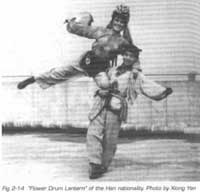 Performers of "yingge" hold two sticks. The performance has some similarity with the "drum yangge", but performers' faces are made up to heroic characters of the famous faction 'All Men Are Brothers' (or 'outlaws ot the Marsh'). The "yingge" is popular in Chaozhou and Shantou of Guangdong Province. Villagers of the two towns, after migrating to Hong Kong, organized youths to perform "yingge" in the Spring Festival. In this way, they express missing their hometown and strengthen the unity among themselves.
Performers of "yingge" hold two sticks. The performance has some similarity with the "drum yangge", but performers' faces are made up to heroic characters of the famous faction 'All Men Are Brothers' (or 'outlaws ot the Marsh'). The "yingge" is popular in Chaozhou and Shantou of Guangdong Province. Villagers of the two towns, after migrating to Hong Kong, organized youths to perform "yingge" in the Spring Festival. In this way, they express missing their hometown and strengthen the unity among themselves.
"Gaoqiao" performers usually tie two long stilts to their feet. High skill is required and the form is lively and various. Because the performers are higher than others on stilts, they can be easily seen. On their "moving stage", they are deeply loved by masses.
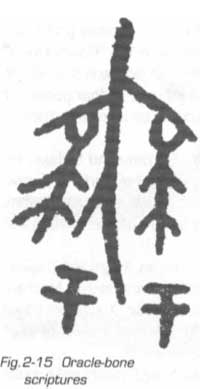 Scholars believe the "Gaoqiao" originates from the totem worship of primitive clans and the fishermen's lives along the coast. Historians have proved that the Danzhu clan in the times of Yao and Shun emperors, who took the crane as their totem, walked on stilts in their sacrificing and imitated dances of the crane (See on Danzhu by Sun Zuoyun). Archaeologists say some oracle-bone scriptures had images of dancing on stilts (See Dances of the Shang oynasty Demonstrated by oracle-Bone Scriptures by Fang Qidong). (Fig.2-15)
Scholars believe the "Gaoqiao" originates from the totem worship of primitive clans and the fishermen's lives along the coast. Historians have proved that the Danzhu clan in the times of Yao and Shun emperors, who took the crane as their totem, walked on stilts in their sacrificing and imitated dances of the crane (See on Danzhu by Sun Zuoyun). Archaeologists say some oracle-bone scriptures had images of dancing on stilts (See Dances of the Shang oynasty Demonstrated by oracle-Bone Scriptures by Fang Qidong). (Fig.2-15)
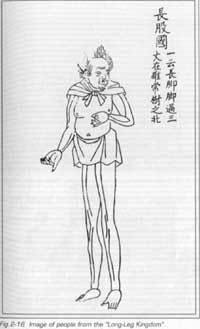 In the ancient geography book Shanhai jing(The Book of Mountains and Seas), there is an account of "Long-Leg Kingdom". According to ancestors, the "Long-Leg Kingdom" was related to "walking on stilts". (Fig.2-16) From the text, readers can imagine a man walking on stilts, holding a long fishing tool to catch fish in the shallow water Jingzu fishermen along the coast of Fangcheng, GuangXi Zhuang Autonomous Region, still keep the Custom of fishing this way. (Fig.2-17)
In the ancient geography book Shanhai jing(The Book of Mountains and Seas), there is an account of "Long-Leg Kingdom". According to ancestors, the "Long-Leg Kingdom" was related to "walking on stilts". (Fig.2-16) From the text, readers can imagine a man walking on stilts, holding a long fishing tool to catch fish in the shallow water Jingzu fishermen along the coast of Fangcheng, GuangXi Zhuang Autonomous Region, still keep the Custom of fishing this way. (Fig.2-17)
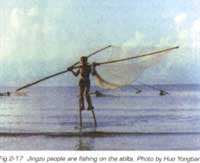 Most stilts used today are made from wood. There are "double stilts', and "single stilt" performances. The double stilts are usually tied to one's shank to fully demonstrate his skill; and the single stilt is held by the performer so that he can go up and down freely. The performance can be also divided into "Wenqiao" (the civil one) and "Wuqiao" (the martial one). The former stresses appearance and amusement, while the latter emphasizes individual unique skill. "Gaoqiao" has now assumed strong local flavor and national color.
Most stilts used today are made from wood. There are "double stilts', and "single stilt" performances. The double stilts are usually tied to one's shank to fully demonstrate his skill; and the single stilt is held by the performer so that he can go up and down freely. The performance can be also divided into "Wenqiao" (the civil one) and "Wuqiao" (the martial one). The former stresses appearance and amusement, while the latter emphasizes individual unique skill. "Gaoqiao" has now assumed strong local flavor and national color.
In the Shandong Province, "Gaoqiao" is done at three levels, and people at the upper level stand on the shoulder of the lower ones.
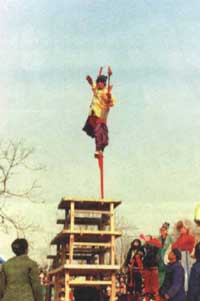 In Beiing and Tianjin, performers show their high skill by jumping on one foot, doing splits or going through obstacles. Some performers can even jump down from four tables high on one foot. (Fig.2-18)
In Beiing and Tianjin, performers show their high skill by jumping on one foot, doing splits or going through obstacles. Some performers can even jump down from four tables high on one foot. (Fig.2-18)
In northeast China, the "Gaoqiao" in southern Liaoning is the most famous. It has complete procedures and a standard form. At first, performers must "Daxiang", that is, one stands on the shoulder of another and do a yangko dance. Then they run to change formations. At last, they perform in groups "catching butterflies", "fishing" and small local operas. (Fig.2-19)
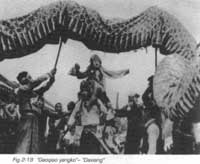 Ethnic groups, in performing "Gaoqiao", usually wear clothes of their own nationality. The Bouyei nationality has both double stilts and single ones; the latter one, due to its simplicity, is especially loved by children. In the "Gaoqiao Shuama" of the Bai ethnic group, performers are dressed like a horse. The "Two-Person Gaoqiao" of the Uygur nationality blend their local dance in it, which is fresh and new.
Ethnic groups, in performing "Gaoqiao", usually wear clothes of their own nationality. The Bouyei nationality has both double stilts and single ones; the latter one, due to its simplicity, is especially loved by children. In the "Gaoqiao Shuama" of the Bai ethnic group, performers are dressed like a horse. The "Two-Person Gaoqiao" of the Uygur nationality blend their local dance in it, which is fresh and new.
Local dances have always been combined with religion and folk Customs. The religious and conventional activities have supplied time and place for Iocal dances to develop.
In ethnic groups of southwest China, conventional dance is very popular Some ethnic groups pass down their history and Culture by means of songs and dances, for they have no written characters of their own. They sing the praises of their ancestors and their hometown. They dance to educate their descendants, simulate spirits and build new homes. For instance, "Caigetang", also known as "Duoye" of the Dong ethnic group, is a grand festivaI in which they offer sacrifices to Gods, pray for a flourishing population and livestock and an abundant harvest of all crops. By then, all villagers, led by revered elders and lusheng rhythm, will congregate in front of "Shengmuci" (memorial temple of Saint Mother, who is the most respected Goddess of the Dong people), doing sacrifices, singing and dancing.
In summary, yangge is a kind of art form which originated from farming and has many forms. Through long years, it was danced to pray for a good harvest and blessing and to entertain gods and man. In 1942, the "New Yangge Campaign" rose in Yan'an. Since then, the "temple fair" (around the temple itself) and "Saihui" (carrying out the sculpture of gods and patrolling) was fundamentally changed. People began to reveal a new life through yangge.
